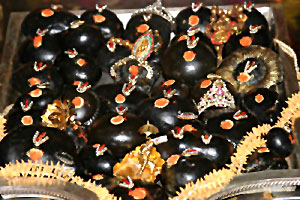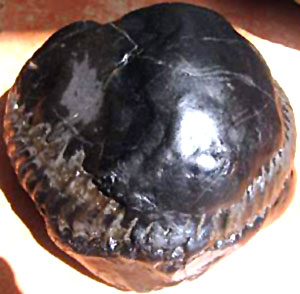In Hinduism Salagrama is said to be a valuable stone-like object of various shapes found at the Gandaki River. These precious stones have special marks like spiral, chakras and thread formed on them. It is believed that Salagramas are sacred as the God is present there and is worshipped. By just looking at the Salagramas, all the sins accumulate will at once get destroyed.
According to Hindus, the natural fire and holy waters represents Lord Brahma. Lord Vishnu is represented in the form of ammonites or shilas called Salagrama Shilas. There are legendary story of Vishnu turning into stone near sacred River Gandaki. This river is also known as Salagrami and is a place of pilgrimage. Salagrama is one of the one hundred and eight temples of Lord Vishnu, where Krishna and Shiva are also worshipped.
 There is a legendary story mentioned in the Varaha Purana as the reason why the stones are called Salagrama. In the ancient times there was a sage by the name Shalankayana, performed austerities and meditated in many holy places to become a great devotee of Lord Vishnu as his son. He visited the sacred place of Muktinatha, near the Gandaki River in Nepal. This holy place was high in the Himalayas, and there Shalankayana took bath in the icy waters of the Kali Gantaki at the back of Annapurna Mountain. The sage was very tired from climbing the high mountain and took rest under a Sala tree.
There is a legendary story mentioned in the Varaha Purana as the reason why the stones are called Salagrama. In the ancient times there was a sage by the name Shalankayana, performed austerities and meditated in many holy places to become a great devotee of Lord Vishnu as his son. He visited the sacred place of Muktinatha, near the Gandaki River in Nepal. This holy place was high in the Himalayas, and there Shalankayana took bath in the icy waters of the Kali Gantaki at the back of Annapurna Mountain. The sage was very tired from climbing the high mountain and took rest under a Sala tree.
The sage Shalankayana was fast asleep on the eastern side of the Sala tree, he didn`t notice that the Lord Vishnu had come and stood before him. Then by the Lord`s kindness the sage woke and saw his Lord standing there and immediately enchanted before the Lord with melodious Vedic hymns. Lord Vishnu then fulfilled the wishes of the sage and endowed him with a son and also another boon.
Lord Vishnu informed that from `the dwadasi in the sukla paksa of the month of Vaisaka` He would forever stay on the area of that mountain in the form of the Salagrama stone. The Sala tree was actually made by the God when his devotee wanted to rest. The Sala tree was a special self-manifesting mercy incarnation of the Lord appearing for His devotee. Accordingly in the same way, the Lord continued to reside in the place in the form of Salagrama Shila. Lord Vishnu will reside there, and the devotees can take Him in this form and worship Him, and the lord will respond to their love in that way. This is mentioned in the epic Mahabharata.
The Salagramas are available in various patterns and marks. A worm called `vajra-kita` was born in the Salagrama stones. This worm was a form of Lord Vishnu. The worm entered into the bowels of these stones. The worm made carves marks of numerous kinds and various other marks with ease in the stones. The worm is believed to reside inside these stones for innumerable years and thus the Lord stayed here.
Some of the distinct features of the Salagrama-stones are colours and shape and size. The sacred Salagrama-stones are available in white, yellow, red, black, green, orange or grey colour. The Salagrama-stones contains stains and they are multi-coloured. The colours might be deep or faded. The Salagrama-stone is illustrated as the `field` for the presence of Godhead.
The Vasudeva-Salagrama is white in colour, the Sridhara-Salagrama is yellow, Vishnu-Salagrama is black stone, Narayana-Salagrama or Shila is greenish in colour, Narasimha-Salagrama is red, Damodara Shila is blue coloured and Vamana-Salagrama is like the whitish in colour. Multi-coloured Salagramas indicates Ananta and a bright-white coloured stone represents Adhoksaja. The stones which are reddish brown like honey represent Lord Brahma and tawny coloured stone represents Narasimha.
Salagrama-stones with the varied colours have diverse effects. The grey-coloured Salagrama stone is specifically suitable for worship by ascetics. The stones which are discolored bring decay and destruction. The multi-coloured stones are not suitable for worship, unless it is Ananta-Salagrama that brings prosperity. Highly coloured stones cause misery; the faded colours destroy the lineage; the colours which are indistinct and uncertain make for death.
The yellowish-brown coloured Salagramas represents the killer of the companion, the bluish-stone and white colour stones bring wealth; the red-stone brings in sovereignty and the black-stones cause nourishment and prosperity. Deep red coloured shilas represents death.
The Salagrama stones also differ with regard to their circumference or parimana, which is measured in terms of the size of the aperture. The right Salagrama will have a thread in the middle and if the aperture is located at the spot which marks one-eight of the thread`s length, then the Salagrama stone is of superior variety. The stone having an opening in the one-third part is to be rejected. If the Salagrama is crooked, it causes disease; if long-mouthed it devours everything. A large Salagrama is by definition eight finger-breadths (of the worshipper) in width; larger than that is recognized as `very large` and is regarded as unsuitable for a householder to worship.
 There are classes of Salagramas. The Brahmanas worship Lakshmi-narayana, Ananta, Hiranya garbha, Purushottama; and Chaturbhuja Salagramas. The Kshatriyas adore Lakshmi-narayana, Ananta, Krishna, Garuda-dhvaja, Gopala, Rama, Sridhar and Aniruddha Salagramas. The Vaishyas worship Lakshmi-narayana, Vasudeva, Pradyumna, Damodara, Pitambara, Hari; and Gadadhara Salagramas. The Sudras worship Lakshmi-narayana, Madhava, Krishna, Achyuta, Aniruddha, Kesava and Pitambara Shilas. Lastly the ascetics many devote to the Narsimha, Hayagriva, Mukunda; and Maha-nila Shilas.
There are classes of Salagramas. The Brahmanas worship Lakshmi-narayana, Ananta, Hiranya garbha, Purushottama; and Chaturbhuja Salagramas. The Kshatriyas adore Lakshmi-narayana, Ananta, Krishna, Garuda-dhvaja, Gopala, Rama, Sridhar and Aniruddha Salagramas. The Vaishyas worship Lakshmi-narayana, Vasudeva, Pradyumna, Damodara, Pitambara, Hari; and Gadadhara Salagramas. The Sudras worship Lakshmi-narayana, Madhava, Krishna, Achyuta, Aniruddha, Kesava and Pitambara Shilas. Lastly the ascetics many devote to the Narsimha, Hayagriva, Mukunda; and Maha-nila Shilas.
There are many Salagramas which must be avoided. The stones are of deformed shaped are worship. The triangular, rough shaped and crescent-shaped stones must not be worshipped. The salagrama-stones which have irregular angles, which are burst, burnt, stained, or warm to touch must be evaded, as also those without chakras, or those which have been embrocated (rubbed and frayed), or which have crooked apertures. The stones with numerous chakras, crooked chakras and chakras at the bottom must be avoided. The stones which are fettered (clasped or joined) or obstructed, the stones which have a cruel, terrible and awesome aspect, and the stones which have crooked snouts must be avoided. The stones which are broken or burst open, the stones which are burnt, and the stones which are triangular in shape must be avoided, as also those which have internally split, and damaged; and the stones which have many scratches and fissures must also be avoided. Hence the Salagramas must be carefully observed according to their value for worship.












